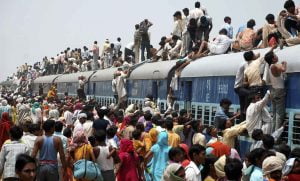The impact of “Population Explosion” (Rapid Growing Population) on India’s economic development.
Is India over-populated? A critical examination of the present population policy.
POPULATION EXPLOSION

The fastest rise in the population of India was during the period of 1951 to 1981, in which the population was from 36 crores in 1951 was reached around 70 crores in 1981. During this period of 30 years, the population increased by around 34 crores, which is the fastest rise in the history of population statistics. Death rate has become controlled due to modern health and medical facilities and it has reduced to become 15 persons per thousand whereas; the birth rate has not got any significant reduction. That is why; this period from 1951 to 1981 is known in India as the period of Population Explosion.
Read about Suggestions To Solve Population Problem and Causes of Population Explosion in India
Population Explosion And Economic Development
Ordinarily, with an increase in population, production also increases, and the number of those people also increases, among whom the total increase in production is distributed. Thus, the ultimate effect of an increase in population on the level of production per head would be indifferent or negative. This would depend on the form of an increase in population and its directions. If the increase is in the number of dependents, then in place of production, consumers would increase, and ultimately the effect on per head production would be adverse. On the contrary, in case of a favorable age constitution of the population, its effect on the economic development would be better.
EFFECTS OF THE INCREASING POPULATION IN INDIA ON ITS ECONOMIC GROWTH
The explosive increase in population in India has adversely affected the economic development and economy, which is clear from the following facts
Lower Growth Rate
Due to the increasing population, the rate of development has been slow. Whereas; the growth rate of Japan during the previous 10 years has been 15%, while the average growth rate of India has been 4% only.
Widespread Poverty
Due to the heavy population, the benefit of economic development is almost nil in the country. Though during the last 30 years there has been an increase of 15% in the national income, still the per capita income has increased ‘50% only. About 50% of the population of the country is below the poverty line. Read about the Problem of Poverty in India
High Prices
Due to a higher population, we find scarcity everywhere and due to scarcity, the prices are heading towards an increase. The country has a scarcity of food-grains, scarcity of employment, scarcity of essentials, scarcity of houses, scarcity of oil, etc..
Excess Burden on the Economy
The 1.5 crore increase in the population each year is increasing the burden on the Indian economy.
Problems in Industrialization
Our country has poverty and unemployment only due to the higher population. The level of savings and investments is lower and mechanization is discouraged due to excess human resources. The small and cottage industries are primary. Due to all these reasons, rapid industrialization has not become possible. The slow pace of capital formation is also a hurdle in industrialization in India.
Expenditure on Population Control
The explosive increase in population in India has forced expenditure of crores of rupees on population control under planned development. These resources would otherwise have been used in the economic development of the country and the standard of living would have improved.
Problem of Unemployment
The means of employment do not increase at the same rate as the increase in population, as a result, the existing problem of unemployment becomes more dreadful. This is the reason for the continuous increase in unemployment in India. At the beginning of the first plan, the numbers of unemployed were 35 million which increased to 26 crores in 2010.
Shortage of Food-gains
Due to the rapid increase in population, to fulfill the requirements of the population for several years, millions of tons of food-grains has to be imported. This has adversely affected foreign trade.
Problem of the Increasing Number of Dependents
The rapid increase in population increases the burden of the number of dependents. According to the 1961 census, 47.3% of the population was dependent which increased today to 71.1%.
Problem of Capital Formation
The increase in income due to economic development is expended in catering to the needs of the increased population, as a result, capital formation cannot be increased and the investment rate remains lower.
Hinders the Growth of Agriculture and Industry
The increasing population hinders the quick development of agriculture.
It has two reasons- Subdivision of land reduces the area of land per person
- The burden of population on agriculture increases.
Similarly, the increasing population hinders the growth of the industry also. A rapid increase in population decreases the savings and investment rates. During a lack of capital, the pace of industrial development is slow.
Increase In the Burden of Public Utility Services
For the rapid increase in population, the government has to incur more on housing, education, health, welfare, law and order, and security. Thus, funds for development work fall short.
